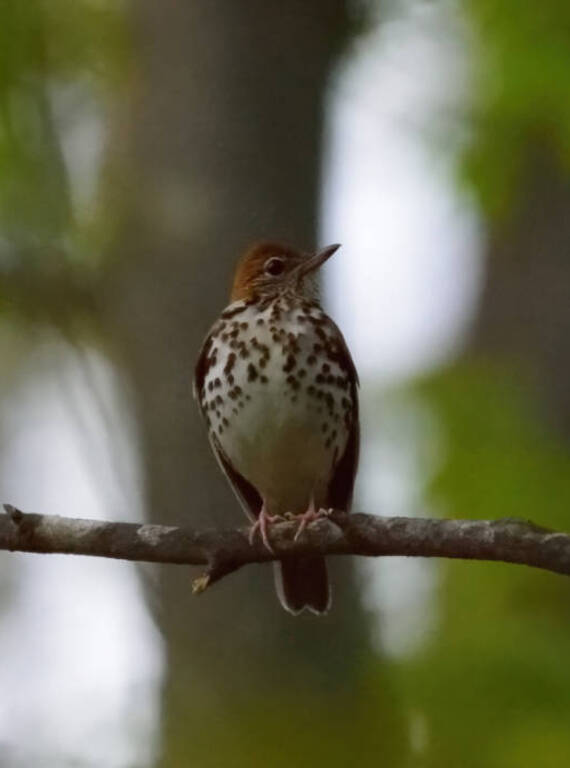Mid-Atlantic Climate Impacts
Changing ecosystems


Wood Thrush
USFWSUrban development, agricultural practices, and infrastructure can harm biodiversity by breaking up natural habitats and putting stress on different species. Climate change exacerbates habitat changes that further threaten the survival of native plants and species. Certain species in the Mid-Atlantic, such as wood thrush, brook trout, and freshwater mussels, are at a greater risk than others. As native species lose their habitat, invasive species—species that are not native to an ecosystem and have negative impacts on the environment—are outcompeting them, causing further harm to the habitats and reducing diversity in the ecosystem.
Forests
Forests are changing in response to increasing temperatures that lead to longer growing seasons. Shorter winters and earlier springs have been reshaping the life-cycle events of plants that use temperatures as cue for growing. For instance, while longer growing seasons may enable plants and trees to grow more, they may struggle to get sufficient water to support their growth due to shifts in precipitation and reduced water available in the soil. Sea level rise impacts coastal forests and ecosystems that are vulnerable to inundation, as well as coastal erosion, flooding, and saltwater intrusion.
In Pennsylvania, about 60 percent of the land is covered by forests, with 54 percent of mixed oak forests and 32 percent northern hardwoods. Conifers and tall trees with broad leaves are at a greater risk when temperatures warm and there is less available water. Habitat loss of conifer forests impacts hundreds of bird species. For example, evening grosbeak birds that Pennsylvania hosts during winter have been experiencing 92% decline across the continent. While leading causes are debated, climate impacts on conifer forests have been discussed as a major factor. Similarly, wood thrush birds also depend on continuous, intact stretches of forests. Many of them were found in the Upper Delaware River watershed and are vulnerable as forests change in response to climate impacts.
Coastal habitats
Forests are not the only ecosystem that birds rely on; salt marshes and beaches also play a crucial role as important stopover sites for migratory shorebirds. Unfortunately, in the Lower Delaware Watershed Bay and Chincoteague National Wildlife Refuge, these habitats face significant threats due to sea level rise and nutrient pollution. Additionally, overfishing is reducing the food source for migratory species in these areas.
One such example of these challenges can be seen in the Blackwater National Wildlife Refuge. Here, rising waters have resulted in more than half of the original wetland habitat being submerged. The Blackwater River has caused extensive marsh conversion to open water, leading to the area being now referred to as “Lake Blackwater.”
This trend of habitat loss and degradation is occurring along the East Coast’s salt marshes, and it poses a severe threat to the survival of various bird species that rely on these ecosystems for shelter, feeding, and migration. Conservation efforts and measures to address sea level rise and pollution are essential to protect these critical stopover sites for migratory birds and maintain the ecological balance of the region.
Sea turtles migrate to the Mid-Atlantic’s coastal areas in late spring as temperature rises. Five of the world’s seven sea turtle species can be found in Virginia. Sea turtles are an imperiled species with each type being either threated or endangered. In response to Earth’s rising temperatures, sea turtles’ migratory patterns have altered. There has been an increasing gender imbalance in the sea turtles’ ecosystem as male sea turtle offspring require nests with colder temperatures. Due to sea level rise, sea turtles have a harder time finding food, as well as finding coral reefs and beaches necessary for their reproduction.
Invasive species
Invasive species tend to thrive in new environments that do not have the natural impediments from their native environments that slow their aggressive growth. As they continue to expand, invasive species threaten the native species by competing for limited resources and degrading complex ecosystems that native species rely on. They also can adapt more quickly to changing climate conditions, and climate threats to native species only leave more room for invasive species to take over.
Invasive species expansion and climate change have a mutually reinforcing relationship. Invasive species can worsen the effects of climate change by degrading habitats, while at the same time, they benefit from the warming temperatures, allowing them to thrive and spread even more rapidly. Mute swans, for one, deteriorate grasses in the Chesapeake Bay watershed that reduce food and damage wildlife habitat. In addition to mute swans, there are about 200 invasive species found in the Chesapeake Bay watershed.
Warmer temperatures not only allow existing invasive species in the Mid-Atlantic to reproduce for a longer time, but also introduce new invasive species to the region. For example, warmer temperatures allow bush species like honeysuckles, privet, and kudzu to expand northward to the Mid-Atlantic.
Coldwater Stream Habitat
In the Mid-Atlantic, one of the habitats most vulnerable to changing climate conditions are coldwater streams. Warming temperatures result in reduced oxygen which is detrimental to fish and wildlife species that rely on the water’s oxygen supply to breathe. In particular, brook trout native to Pennsylvania, Maryland, West Virginia, and Virginia have been stressed by warmer streams. Warming temperatures also accelerate eutrophication in waters, further stressing out the wildlife in waters.
Whether it’s forests or shorelines or coldwater stream habitats, changing climate conditions are endangering the survival of many native species. In turn, invasive species become more effective at outcompeting and further fragmenting the ecosystems. Active mitigation strategies that encourage the conservation and regrowth or rehabilitation of natural habitats are needed to protect the ecosystems across the Mid-Atlantic.
What does this mean for national parks?
National parks provide a refuge for many endangered species protected under the Endangered Species Act. Park landscapes can offer refuge to flora and fauna from developed areas because they maintain the interconnectedness in the natural ecosystem that species depend on to find shelter, food, and reproduce. For many wildlife, parks are their home. For example, Shenandoah National Park hosts over 190 bird species, over 50 mammal species, over 20 reptile and amphibian species, over 40 species, and many other insects, spiders, and invertebrates. Shenandoah is also a safe haven for the endangered lungless salamander that only survives in cool microclimates found in Shenandoah’s high elevation points.
The National Park Service takes active measures to protect the natural habitats. This includes controlling the expansion of invasive species as well. In Rock Creek Park, the rapid expansion of whitetail deer population threatens vegetation. The park now prescribes an annual reduction of whitetail deer density to protect its forest. In addition, there are 200 non-native plant species in Rock Creek Park. In response, NPS uses the Early Detection and Rapid Response strategy to locate and remove invasive plants.
Make a tax-deductible gift today to provide a brighter future for our national parks and the millions of Americans who enjoy them.
Donate Now
